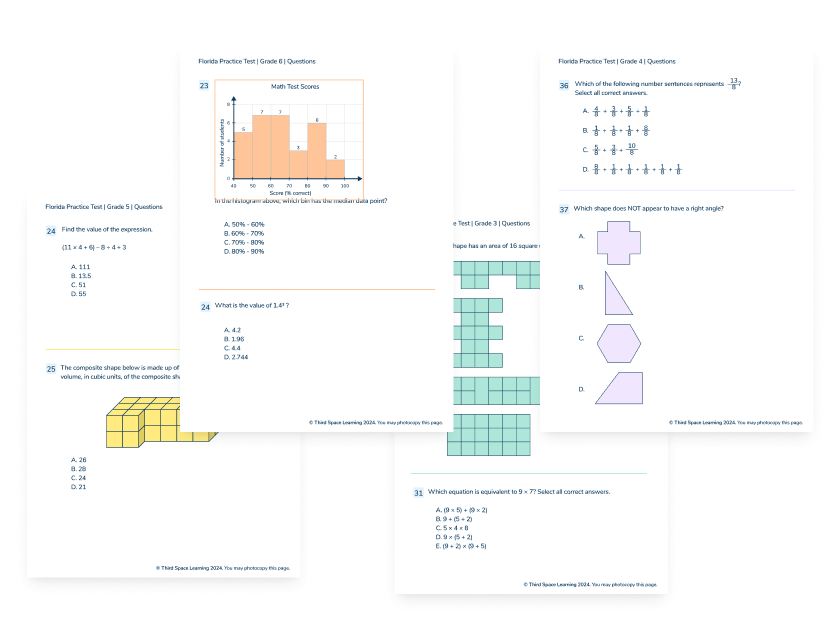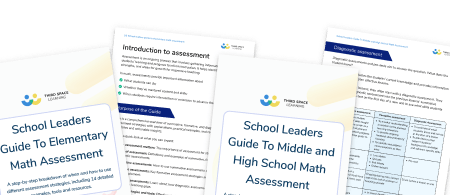Formative Vs Summative Assessment: The Differences Explained
The assessment landscape in schools is often confusing and ever-changing. With the debate between the merits of formative vs summative assessments raging on, it can be difficult to know when to use either of these assessment types in your classroom. That’s why, in this article, we will discuss when you should use either type of assessment and explain why.
Formative vs summative assessments – what is the difference?
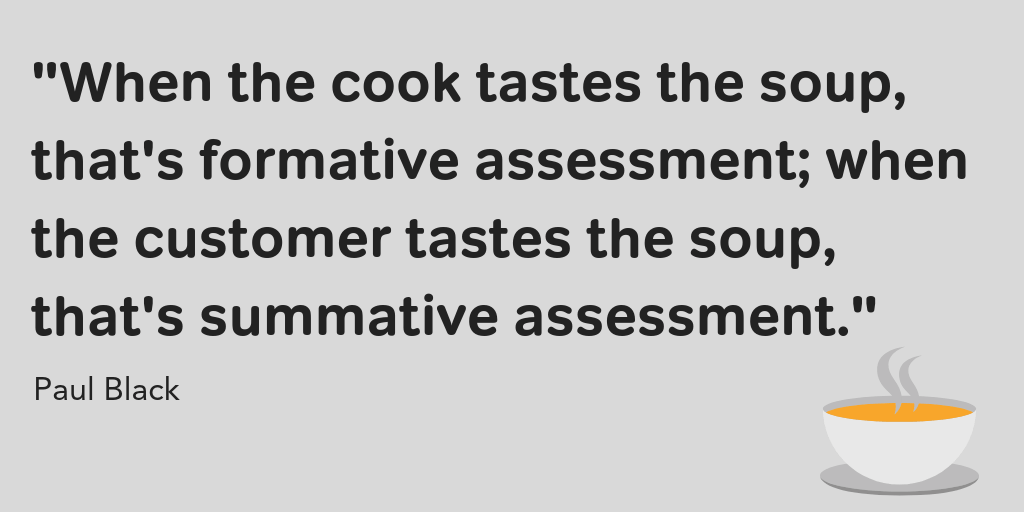
Formative vs summative: When teachers discuss assessment, they often refer to two types – ‘formative’ and ‘summative’. However, the distinctions and lines between the two types of assessment are often blurred and misunderstood.
This article compares and contrasts formative and summative assessments to give you a true view of the difference between both types.
School Leaders Guide To Math Assessment
A guide to the different assessment types for elementary, middle and high school, with examples, strategies and free resources to use in your school.
Download Free Now!
What is formative assessment?
Formative assessment is the use of day-to-day assessments to gauge and explore students’ understanding of a topic with the ultimate goal of adapting instruction to improve student learning.
Think of it as an assessment for learning.
Formative assessments help inform the learning ‘in the moment’. Formative assessment is a continuous and informal classroom assessment. It should have a central and pivotal role in every math classroom.
If used correctly, it will highly impact current learning and help guide your instruction. Teachers should use student data to identify areas for improvement and give targeted feedback and instruction to learners who need it.
Low-stakes assessments like formative assessments allow students to develop their skills, confidence and experience before attempting high-stakes summative assessments. It also makes room for self-assessment.
Some examples of formative assessment, or assessment for learning examples, include:
- Daily exit tickets;
- Check-ins (for example, writing answers on whiteboards);
- Think-pair-share;
- Quick writes;
- Quizzes (online or paper);
- Student interactions inside and outside of class;
- Student teacher conferences
What is summative assessment?
Summative assessments are final exams after students complete a block of work, whether that is at the end of a unit, course or quarter.
They are a more formal way to sum up student progress and offer a final grade. Often, they are compared against a standard benchmark.
Think of summative assessments as assessments of learning.
There are different types of summative evaluations that we carry out ‘after the event’, often periodic (rather than continuous), measured against a set standard.
Summative assessment helps to validate and ‘check’ formative assessment – it is a periodic measure of overall student achievement in mathematics after an instructional unit. They are usually formally graded.
If formative assessment is continually carried out, then the results of summative assessment shouldn’t yield any surprises.
Some common examples of summative assessment include:
- Tests
- Reports
- Papers
- Final projects

Meet Skye, the voice-based AI tutor making math success possible for every student.
Built by teachers and math experts, Skye uses the same pedagogy, curriculum and lesson structure as our traditional tutoring.
But, with more flexibility and a low cost, schools can scale online math tutoring to support every student who needs it.
Find out moreFormative and summative assessments should be adaptable
Importantly, it is not the ‘form’ of assessment that determines whether it is formative or summative, but how it is used.
For example, questions from common summative assessments, such as state tests or finals assessments can be used for formative purposes, for example, as an exit tickets (questions given to students at the end of the lesson to check student understanding).
It is important that in all subjects, but especially in math, we use a combination of both assessment strategies. However, due to its constant nature, formative assessment should make up the bulk of assessment activities.
Formative vs summative assessment comparison chart
This Venn diagram shows the differences and similarities between the two assessment types very clearly.
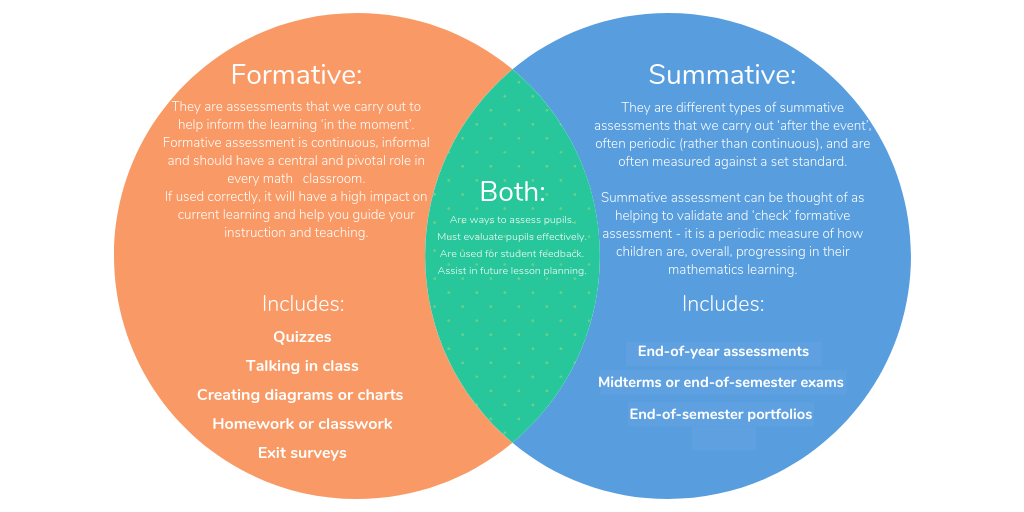
Formative assessment – Constantly assessing ‘in the moment’.
Formative assessment is an intrinsic part of both teaching and student progression. This form of assessment does not rely upon tests and results, but rather the ability to adapt to classroom blockers as they arise.
It should use clear criteria to indicate what a good piece of work is and why this is the case to enhance students understanding. It also gives you as a teacher a chance to see when things are not going so well and act upon it and see improvements.
Good formative feedback is a crucial ingredient in effective formative assessment examples. It enables the teacher and student to plan the next stage of their progression and future learning goals together.
How to bring formative assessments into your classroom
During a lesson, all classroom staff adults should be on a ‘constant assessment mission’ through interactions with students.
Teachers should move around the room and interact with each child assessing their progress towards the learning objective in real-time.
In the moment, assessment can take many forms:
• Use questions from your shared learning to assess where you need to give independent work, or which students need further support
• Ask key questions to students during their independent work
• You could use ‘exit tickets’ to assess children’s understanding at the end of a lesson
However, this ‘in the moment’ assessment must have a purpose, and use the information to adapt the learning experiences and opportunities provided to each child.
Information obtained from formative assessments can help you understand the student’s learning processes and adapt this in future lesson plans.
If your assessment shows that students are secure, then how are you going to deepen their learning?
If your assessment shows that students have some misconceptions, how will you support these?
These are just two of the questions to ask yourself throughout a formative assessment.
HOW THIRD SPACE LEARNING EMBEDS FORMATIVE ASSESSMENT IN EVERY ONE-ON-ONE MATH TUTORING LESSON
Throughout their learning journey with Skye, Third Space’s AI math tutor, trained by teachers and math experts, students start each lesson with a ‘Skill Check In’ – a carefully designed question that assesses their understanding of the math topic they’ll be working on during their one-on-one session.
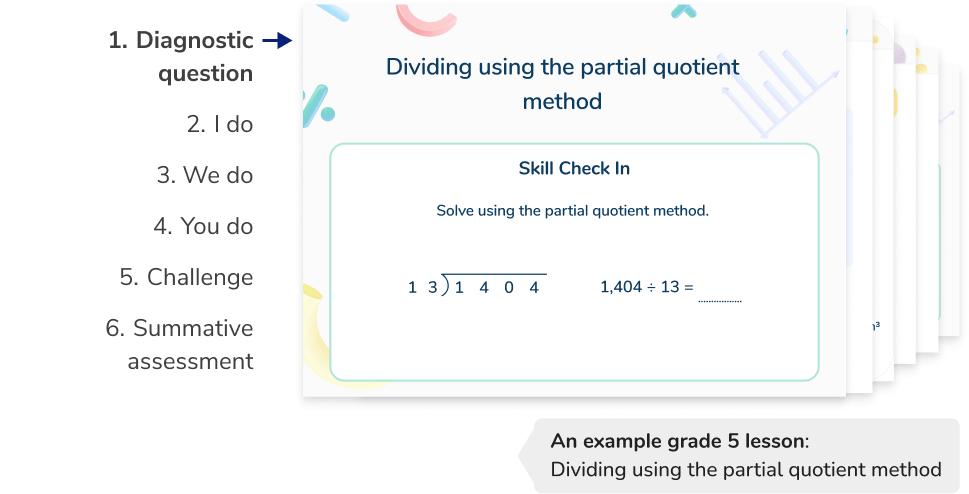
If the student gets the question wrong or struggles, Skye uses scaffolding to teach step by step; modeling a similar example and working through guided questions first before moving toward independent practice and challenge. If the student answers the question correctly and demonstrates readiness, Skye moves straight to application and challenge.
Formative assessment continues throughout the lesson as Skye identifies misconceptions and adjusts hints in real time to support learning.
Each lesson ends with a short summative assessment called the ‘Skill Check-Out’, which measures understanding and tracks progress, followed by a quick confidence check.
Formative assessment ideas for your class
To keep up with the progression of your math class, there are several assessment routines you can use.
Common types of formative assessment include:
- Group activities
- Quizzes
- Games
- Class projects
- Presentations
Ensure each formative assessment routine has a purpose
Make sure that your assessment ‘routines’ have purpose and use.
For example, if you are going to do the ‘math lesson classic’ and ask children to show you an answer on a mini-whiteboard, ensure you look at every student’s answers.
Use these to inform the next step in your lesson and the learning for each student.
I have observed many lessons where teachers have carried out common formative assessments such as the mini-whiteboard ‘routine’ but they have not actually looked at the responses given, not reflected on this valuable student data, and carried on with what they had planned regardless.
Remember, it’s not the activity or ‘thing’ you do that represents effective assessment, but what you do with the information you gather.
Through effective in-lesson assessment, you can ensure that each student receives support and challenge and that every student is learning rather than constantly rehearsing what they already know.
Don’t leave any potholes – why formative assessment is important
I often use a ‘pothole’ analogy with the schools I work with. Imagine a local district was filling in potholes but their road maintenance vehicles were creating new holes in the road.
They wouldn’t be improving the overall road surface quality, would they?
Yet, schools often inadvertently do the same with math. Often, they are very good at carrying out a plethora of intervention activities to fill gaps (or potholes) that have been ‘left’ from previous years. Yet, simultaneously create new gaps (or potholes).
It is therefore important that we use our constant, ‘in the moment’ assessment to help ensure that no new gaps are being allowed to form in a student’s mathematical understanding and learning.
Make sure to use your ‘in the moment’ and ‘end of lesson’ assessments to help fill any new emerging gaps.
At the end of the math lesson, formatively check that all students are secure with the objective for that lesson and if not, carry out some form of intervention to help address these gaps.
If you do not address the gaps now, then who is? And when?
4 things you must remember regarding summative assessment
Summative assessment helps to demonstrate the extent of students’ success in meeting specific goals. It is a method that can be used to quantify achievement, and due to its data-driven nature, it is a great way to provide a numerical basis for a student’s next step.
However, while the principles of summative assessment are simple, there are 4 key points you need to consider before implementing it in your classroom.
1. Assessment systems vs framework – What are you assessing against?
Despite the power of ‘in the moment’ formative assessment, schools need a way to track the attainment and progress of students throughout the school.
This need means schools should also consider the assessment framework they are using- i.e. what they are assessing against. Often, this is a district level decision.
However, you must be clear about the difference between your assessment system and the framework you are using. Often, working in schools, they tell me that they use ‘student asset’, ‘classroom monitor’, ‘target tracker’ (and many others) as their assessment. These are all assessment systems – software that allows you to record and track student’s progress against the school’s chosen framework.
They are not what you are using to ‘assess’- merely what you are using to record your assessment.
These assessment systems all allow you to select (and often create your own) framework upon which to assess your students. These frameworks are vitally important.
2. Balancing the frameworks is crucial
When choosing, or creating, the assessment framework you are using, it’s important to consider the balance of objectives and target areas of mathematics within the framework.
Some end-of-grade tests may give a higher weight towards number-based objectives, with number, calculations and proportionality making up between 75-85% of a child’s final result.
Yet, most grades have an even split between all standard domains.
This essentially means that a child could be legitimately marked as ‘secure’ or ‘working at aged-related expectations’ against the whole curriculum, based on their strength in geometry, even though they wouldn’t be classed as ‘secure’ or ‘working at aged-related expectations’ in a standardized test.
Ensure your framework is balanced, and includes an equal weighting of standards-based questions.
There are many ways in which you can do this, including:
Use built-in ‘weighting’ functions of some assessment systems that allow you to weight each objective.
• Assess against key objectives only, which balance number vs non-number objectives.
• Group objectives together, creating the overall numbers vs non-number balance.
• Use a commercially available assessment framework which does the weighting work for you.
3. Teacher assessment plays a huge role in summative assessment
Once your school decides on a framework for assessment, the next question is how to use it.
These frameworks can be used both in a purely summative or formative way, leading to an accurate summative assessment.
The traditional use of these frameworks is for schools to ask each child to be assessed against the framework at set points, for example, midway through the school year or end-of-grade tests.
This often leads to ‘assessment panic’ and teachers feel overwhelmed having to create the assessment against many objectives for all students in their task in a short period.
If this is the only way these frameworks are used, then these are purely summative – it is the teacher’s judgment at the end of a quarter/year.
Due to the stress of meeting a deadline and making a judgment against each objective for all students in your class, often these summative-only teacher assessments aren’t as accurate as many would like.
Luckily, you can adapt these assessments very easily
However, these frameworks can also be formative. Teachers are encouraged to record the learning progress towards objectives on the framework or rubric as they are taught.
An example of this is recording and amending judgements each week resulting the ‘ongoing’ assessment. This leads to an ever-changing snapshot of each child’s performance, which can be powerful.
This can inform interventions and subsequent teaching and help to identify common misconceptions, giving the assessment framework used by your school both a summative and formative use.
These assessments can then be finalized in time for whatever deadline ‘snapshot’ date your school set.
It is fantastic that many schools and districts favor teacher assessment to provide this ‘data.’
Teacher assessment is incredibly powerful and gives teachers the professional autonomy they deserve.
4. Testing can’t be forgotten about either
Many schools also use some form of testing alongside their assessment frameworks.
This helps validate teacher assessment judgments, and can also help to ensure there are no ‘nasty’ surprises when it comes to state standardized tests.
However, testing is only as good as the test quality used. The tests your schools reliy on must have the same degree of ‘standardization’.
They should be standardized so you know how children across the country perform based on a clear test development framework, and have been trialed and refined in schools.
Some popular tests developed in this way include STAR Math and Terra Nova.
Regardless of the tests used, schools and teachers must understand that they provide a snapshot of student performance on test day.
Children, like adults, all have ‘good’ and ‘bad’ days, and these tests must be seen as a supplement to good quality teacher assessment, not a replacement for it.
Formative vs summative assessments – the pros and cons
Both formative and summative assessments have an important role in the classroom and schools. However, you must ensure the right balance between the two approaches for your own class’s learning needs.
Constant formative assessment can prove difficult if not implemented properly. But, consistent assessment of students’ strengths and weaknesses can prove invaluable in helping them to progress.
Summative assessment often doesn’t show the whole picture of a student’s progression, but it is a fantastic way of getting a data-driven overview of how a student has progressed and grown over a period.
The goal of this blog was to summarize the difference between formative and summative assessment, and the conclusion is that both approaches have flaws.
They can both also provide valuable insight into how a class progresses throughout the school year.
Remember to use assessments of both kinds to inform your teaching!
Do you have students who need extra support in math?
Skye—our AI math tutor built by experienced teachers—provides students with personalized one-on-one, spoken instruction that helps them master concepts, close skill gaps, and gain confidence.
Since 2013, we’ve delivered over 2 million hours of math lessons to more than 170,000 students, guiding them toward higher math achievement.
Discover how our AI math tutoring can boost student success, or see how our math programs can support your school’s goals:
– 3rd grade tutoring
– 4th grade tutoring
– 5th grade tutoring
– 6th grade tutoring
– 7th grade tutoring
– 8th grade tutoring
The content in this article was originally written by math consultant and author Tim Handley and has since been revised and adapted for US schools by elementary math teacher Katie Keeton.
Formative vs summative FAQs
Formative assessment is the use of day-to-day assessments to gauge and explore students’ understanding of a topic with the ultimate goal of adapting instruction to improve student learning. Summative assessments are final exams after students complete a block of work, whether that is at the end of a unit, course or quarter.
They are a more formal way to sum up student progress and usually offer a final grade. However, remember that it is not about the form of assessment, but how the information is used.
Examples of formative assessment include: Daily exit tickets; Think-pair-share; Quizzes (online or paper). Examples of summative assessment include: State assessments and NAEP (National Assessment of Educational Progress); mid-term exams, final exams, quarterly assessments; AP, ACT and SAT.
An exit ticket is an example of formative assessment. They are a valuable tool used by teachers to gather feedback on students’ understanding of learning content.
